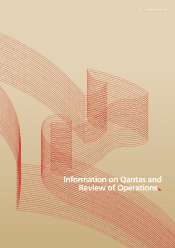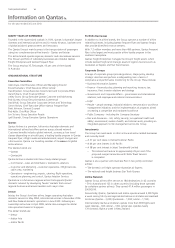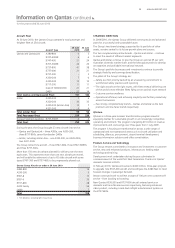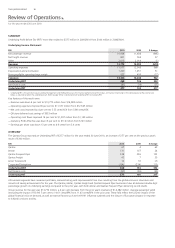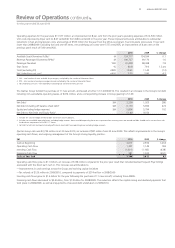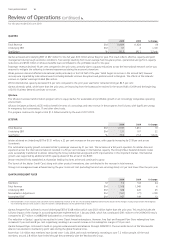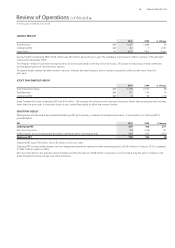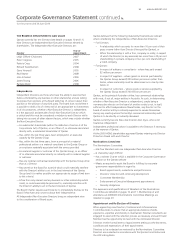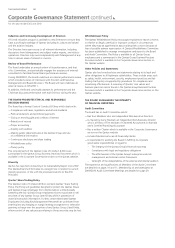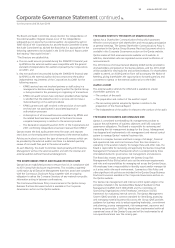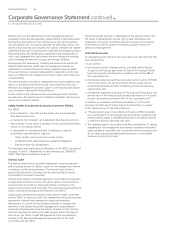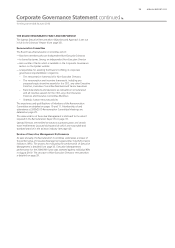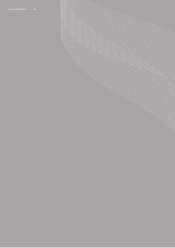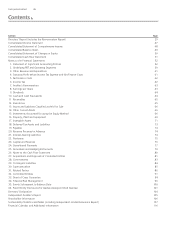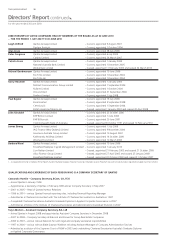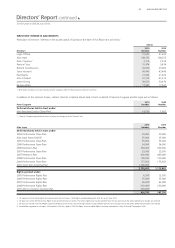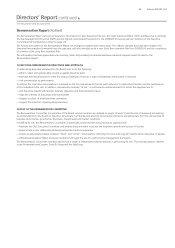Qantas 2010 Annual Report Download - page 25
Download and view the complete annual report
Please find page 25 of the 2010 Qantas annual report below. You can navigate through the pages in the report by either clicking on the pages listed below, or by using the keyword search tool below to find specific information within the annual report.
23 ANNUAL REPORT 2010
for the year ended 30 June 2010
The Board and Audit Committee closely monitor the independence of
the external auditor. Regular reviews occur of the independence
safeguards put in place by the external auditor. As required by section
300(11D)(a) of the Corporations Act and the Audit Committee Charter,
the Audit Committee has advised the Board that it is appropriate for the
following statement to be included in the 2010 Directors’ Report under
the heading “Non-audit Services”:
“The Directors are satis ed that:
a. The non-audit services provided during the 2009/2010 nancial year
by KPMG as the external auditor were compatible with the general
standard of independence for auditors imposed by the Corporations
Act 2001; and
b. Any non-audit services provided during the 2009/2010 nancial year
by KPMG as the external auditor did not compromise the auditor
independence requirements of the Corporations Act 2001 for the
following reasons:
– KPMG services have not involved partners or staff acting in a
managerial or decision-making capacity within the Qantas Group
or being involved in the processing or originating of transactions
– KPMG non-audit services have only been provided where Qantas
is satis ed that the related function or process will not have a
material bearing on the audit procedures
– KPMG partners and staff involved in the provision of non-audit
services have not participated in associated approval or
authorisation processes
– A description of all non-audit services undertaken by KPMG and
the related fees have been reported to the Board to ensure
complete transparency in relation to the services provided
– The declaration required by section 307C of the Corporations Act
2001 con rming independence has been received from KPMG”
Qantas rotates the lead audit partner every ve years and imposes
restrictions on the employment of ex-employees of the external auditor.
Policies are in place to restrict the type of non-audit services which can
be provided by the external auditor and there is a detailed quarterly
review of non-audit fees paid to the external auditor.
At each Meeting, the Audit Committee meets privately with Executive
Management without the external auditor and with the internal and
external auditors without Executive Management.
THE BOARD MAKES TIMELY AND BALANCED DISCLOSURE
Qantas has an established process to ensure that it is in compliance with
its ASX Listing Rule disclosure requirements. This includes a quarterly
con rmation by all Executive Management that their areas have complied
with the Continuous Disclosure Policy, together with an ongoing
obligation to advise the Company Secretary of any material non-public
information arising in between con rmations.
The Continuous Disclosure Policy is summarised in the Qantas Group
Business Practices Document which is available in the Corporate
Governance section on the Qantas website.
THE BOARD RESPECTS THE RIGHTS OF SHAREHOLDERS
Qantas has a Shareholder Communications Policy which promotes
effective communication with shareholders and encourages participation
at general meetings. The Qantas Shareholder Communications Policy is
summarised in the Qantas Group Business Practices Document which is
available in the Corporate Governance section on the Qantas website.
Qantas makes all ASX announcements available via its website. In
addition, shareholders who are registered receive email noti cation of
announcements.
The 2010 Notice of Annual General Meeting (AGM) will be provided to
all shareholders and posted on the Qantas website, and the 2010 AGM
will be available for viewing by live and archived webcast. For shareholders
unable to attend, an AGM Question Form will accompany the Notice of
Meeting, giving shareholders the opportunity to forward questions and
comments to Qantas or the external auditor prior to the AGM.
Auditor at AGM
The external auditor attends the AGM and is available to answer
shareholder questions on:
—The conduct of the audit
—The preparation and content of the auditor’s report
—The accounting policies adopted by Qantas in relation to the
preparation of the Financial Report
—The independence of the auditor in relation to the conduct of the audit
THE BOARD RECOGNISES AND MANAGES RISK
Qantas is committed to embedding risk management practices to
support the achievement of business objectives and ful l corporate
governance obligations. The Board is responsible for reviewing and
overseeing the risk management strategy for the Group. Management
has designed and implemented a risk management and internal control
system to manage Qantas’ material business risks.
Qantas is a complex business and faces a range of strategic, nancial
and operational risks and is not immune from the risks inherent in
operating in the aviation industry. To manage these and other risks, the
Board is responsible for reviewing and approving the Qantas Group Risk
Management Framework (Framework) which is underpinned by three
interrelated elements: governance, risk management and assurance.
The Board also reviews and approves the Qantas Group Risk
Management Policy (Policy) which sets out the minimum requirements
and roles and responsibilities for managing risk across the Qantas Group.
All employees have a responsibility to identify, report and/or manage risk
as it arises within the work environment. Summaries of the Policy and
other signi cant risk policies are included in the Qantas Group Business
Practices Document available in the Corporate Governance section on
the Qantas website.
The Qantas risk management and internal control system aligns to the
principles included in the Australian/New Zealand Standard on Risk
Management (AS/NZS ISO 31000:2009) and the Committee of
Sponsoring Organisations of the Treadway Commission (COSO)
framework for evaluating internal controls. The Qantas Management
System (QMS) provides a common standard for identifying, assessing
and managing material business risks across the Group. QMS provides
guidance for business units to adopt regarding leadership, commitment
and planning, process management, risk management, assurance and
training and promotion. QMS has already been implemented within all
operational areas of the Qantas Group and will be implemented to all
non-operational areas over the coming year.
Corporate Governance Statement continued


